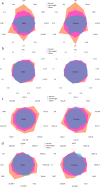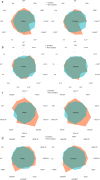Lifestyle and demographic associations with 47 inflammatory and vascular stress biomarkers in 9876 blood donors
- PMID: 38493237
- PMCID: PMC10944541
- DOI: 10.1038/s43856-024-00474-2
Lifestyle and demographic associations with 47 inflammatory and vascular stress biomarkers in 9876 blood donors
Abstract
Background: The emerging use of biomarkers in research and tailored care introduces a need for information about the association between biomarkers and basic demographics and lifestyle factors revealing expectable concentrations in healthy individuals while considering general demographic differences.
Methods: A selection of 47 biomarkers, including markers of inflammation and vascular stress, were measured in plasma samples from 9876 Danish Blood Donor Study participants. Using regression models, we examined the association between biomarkers and sex, age, Body Mass Index (BMI), and smoking.
Results: Here we show that concentrations of inflammation and vascular stress biomarkers generally increase with higher age, BMI, and smoking. Sex-specific effects are observed for multiple biomarkers.
Conclusion: This study provides comprehensive information on concentrations of 47 plasma biomarkers in healthy individuals. The study emphasizes that knowledge about biomarker concentrations in healthy individuals is critical for improved understanding of disease pathology and for tailored care and decision support tools.
Plain language summary
Blood-based biomarkers are circulating molecules that can help to indicate health or disease. Biomarker levels may vary depending on demographic and lifestyle factors such as age, sex, smoking status, and body mass index. Here, we examine the effects of these demographic and lifestyle factors on levels of biomarkers related to activation of the immune system and cardiovascular stress. Measurements of 47 different proteins were performed on blood samples from nearly 10,000 healthy Danish blood donors. Measurement data were linked with questionnaire data to assess effects of lifestyle. We found that immune activation and vascular stress generally increased with age, BMI, and smoking. As these measurements are from healthy blood donors they can serve as a reference for expectable effects and inflammation levels in healthy individuals. Knowledge about the healthy state is important for understanding disease progression and optimizing care.
© 2024. The Author(s).
Conflict of interest statement
The authors declare no competing interests.
Figures







References
Grants and funding
- NNF17OC0027864/Novo Nordisk Fonden (Novo Nordisk Foundation)
- NNF17OC0027594/Novo Nordisk Fonden (Novo Nordisk Foundation)
- NNF14CC0001/Novo Nordisk Fonden (Novo Nordisk Foundation)
- 101017562/EC | Horizon 2020 Framework Programme (EU Framework Programme for Research and Innovation H2020)
- 8020-00403B/Det Frie Forskningsråd (Danish Council for Independent Research)
LinkOut - more resources
Full Text Sources
Research Materials

